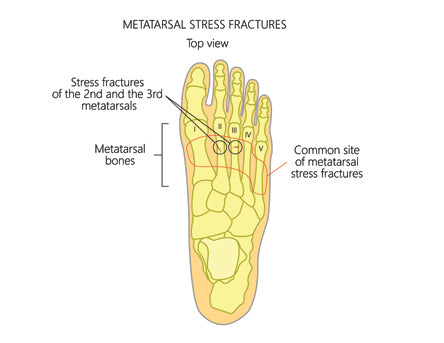Stress Fractures: Causes, Symptoms, and Treatment
A High Impact Overuse Injury
Feeling pain in your foot after constant high-impact activity?
It could be a stress fracture. Frequently seen in athletes, a stress fracture is a small but painful break in high-impact areas of the foot. The break is caused by repetitive stress on the bone, resulting in a small crack in the bone.

If it is not treated properly the bone may fracture all the way through.
What Are Stress Fractures?
A stress fracture is a small but painful fracture in the bones of the foot, most commonly seen in athletes.
A stress fracture is similar to a bone bruise and typically occurs after some type of trauma or overuse. There are five main types of stress fractures, and they can occur in different areas of the foot. They are:
- Calcaneus (heel)
- Fibula (the outer bone of the lower leg and ankle)
- Talus (the lower bone in the ankle joint)
- Sesamoids (two tiny bones associated with the tendons of the big toe)
- Navicular (a bone in the midfoot)
The pain from a stress fracture in the foot is usually sudden, and it is usually difficult to pinpoint the exact moment of injury.

A stress fracture is a small but painful fracture in a bone of the foot, most commonly seen in athletes.
What Are the Symptoms of Stress Fractures?
Symptoms of a stress fracture include:
- Pain/swelling at the site of the fracture
- Tenderness and pain when touched on a bone
- Pain that begins after starting an activity and subsides with prolonged rest.
- Pain that is worse on one side, such as jumping to one leg or shifting weight
If left untreated, the pain from a stress fracture can become quite severe. There is also a risk that the fracture can become displaced, meaning the fractured bone is out of alignment. Depending on the area of a stress fracture, certain stress fractures can be at higher risk than others.
What Causes Stress Fractures?
Often, a stress fracture is caused by repetitive force or stress on a particular foot bone.
It is often seen in runners and others who participate in high-impact athletic activities that include running and jumping. It frequently develops in people who suddenly increase physical activity, such as army recruits or students who begin a new school sport. It can also be caused by a biomechanical issue in the gait cycle in which the foot does not offload pressure properly.
Primary causes include:
- Poor technique in sports/training
- Too rapid an increase in volume when training
- Changing the surface you are training on (grass to concrete, for example)
- Running on an incline
- Exercising with improper footwear
- Specializing in a sport at too young an age (for example, youths playing a sport year-round)
There are other contributing factors as well, such as:
- Age: Older athletes may have lower bone density, which can elevate the risk of getting a stress fracture.
- Weight: Both ends of the spectrum can be at risk. Someone who is underweight may have weakened bones, and someone who is overweight may be putting more stress on their bones.
- Foot problems: Issues such as blisters, bunions, tendonitis, or low/high arches can put undue stress on your body and put you at a higher risk of getting a stress fracture.
Medical conditions: Osteoporosis and other diseases that weaken your bones can elevate the risk of getting a stress fracture.

Often a stress fracture is caused by repetitive force or stress on a particular bone of the foot.
How Can I Treat Stress Fractures?
If you believe you may have a stress fracture, you should see a doctor for a diagnosis and a treatment plan.
This is important because if you continue without treatment, the condition can worsen. You will need to avoid the activity that caused the stress fracture and avoid pressure on the foot while the injury heals. The doctor may have you wear a boot or another type of device to keep pressure off the area of the fracture. Your treatment plan will most likely include rest and, at one point, some type of orthosis for the foot. A shoe with a stiff rocker bottom may help aid in the healing process.
It is always important to pay attention to your footwear, especially if you are participating in high-impact sports.
Some popular shoe companies make athletic shoes with very soft cushioning, which can eventually lead to foot problems and injuries. Usually, the best shoes for sports and other activities will have a firm foundation and possibly a firm cushion – in other words, you may want to stay away from those bendy, twisty shoes! Many athletes also benefit from an insole or orthotic to help properly control the motion of the foot during sports.
If you choose to purchase insoles to provide support, ease discomfort, or potentially prevent stress fractures, we recommend getting one that will work with your specific sport.
Browse our collection of insoles by activity/sport to find a pair of insoles to provide support and cushioning while you’re on your feet.
How To Prevent Stress Fractures
Fortunately, stress fractures are fairly easy to avoid, they just require a few simple steps to follow.
- Gradually increase exercise
- Wear proper footwear
- Mix things up in your workouts
Be Gradual With New Exercise Routines
When switching up exercise routines or getting back to the gym after a period of time off, it’s important to ease into the exercise a bit rather than rush into many new exercises all at once.
Use Proper Footwear
Make sure your shoes fit well and are appropriate for your activity. Using insoles for extra support in your shoes can also be beneficial. Unsure of where to start? Check out our insole advisor to get set up with the right insoles for you.
Mix Things Up With Your Workouts
Add low-impact activities to your workout routine to mix things up. This type of cross-training will help your general fitness and keep your body healthy. It can also help prevent stress fractures that come with repeated motions.
What to Look For When Buying Insoles For Stress Fractures
When purchasing insoles to ease the symptoms of stress fractures, it’s important to select ones that add proper cushioning and support to your shoes. We recommend looking for insoles with the following:
- Cushioning: Crucial for reducing impact forces on the injured bone. Look for shock-absorbing materials like premium EVA foam or gel pods, particularly under the affected area of your foot.
- Firm support structure: The insole should have enough rigidity to limit excessive foot motion that could aggravate the fracture. This provides a stable platform that helps immobilize the injured area.
- Targeted pressure relief: Some therapeutic insoles feature softer zones which are positioned under the fracture site to reduce pressure on the injured bone.
- Full-length design: Choose insoles that support your entire foot from heel to toe, as partial inserts may create pressure differentials that could stress the healing bone.
